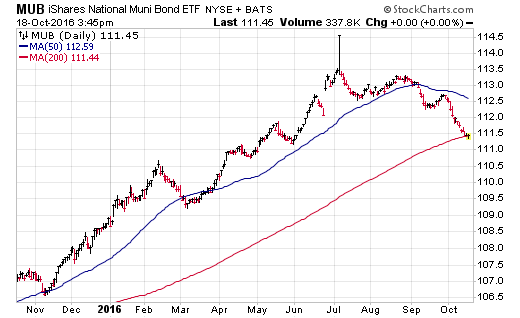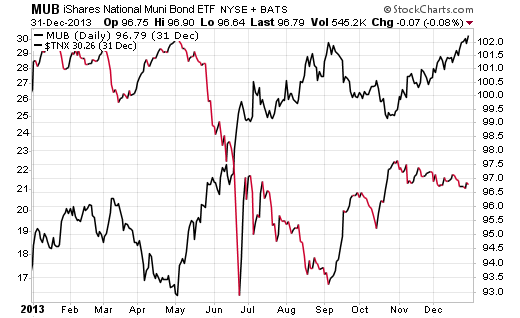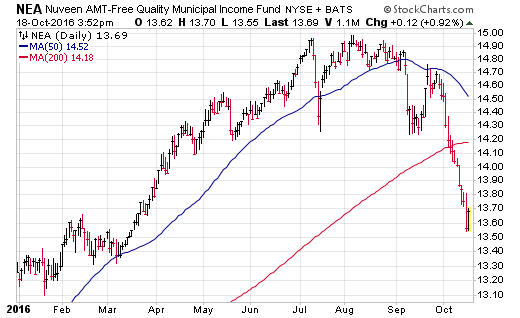Municipal bond funds are typically held for their tax-free income properties and low risk profile rather than their growth prospects. These investments are beloved and often over-weighted in large taxable accounts for their ability to skirt IRS levies that traditional bond income generates.
Yet despite this narrow investment thesis, it’s hard to ignore falling prices that quickly eat up a meager income stream and ultimately erode your total return. Such is the environment that municipal bond investors find themselves in as rising interest rates depress fund prices that peaked near the middle of 2016.
As an example, the iShares National Muni Bond ETF (NYSE:MUB is the largest diversified ETF in this field with over $7.7 billion in total assets. MUB is home to 3,200 individual municipal debt securities around the country that are primarily centered in California, New York, and Texas. This fund currently offers a 30-day SEC yield of just 1.38% and sports an effective duration of 6.21 years. It’s essentially a large, diversified, and transparent way to view the broad state of the municipal bond market.
As you can see on the chart below, MUB has declined 2% from its all-time peak and is in the process of testing its 200-day moving average. In just a manner of three months, this portfolio has managed to give back over a full years’ worth of income and is in jeopardy of breaking its long-term trend line.

A 2% decline may not seem like much from a relative sense when viewed against the volatility in long-term Treasuries, high yield debt, or even stocks. However, this decline represents roughly half of one year’s average annual gain and may be a signal that this sector is due for a sharper correction.
Consider that during the taper tantrum of 2013, MUB fell nearly 9% from high to low as the 10-Year Treasury Note Yield (TNX) rocketed higher.

There has also been a high level of demand for riskier municipal bond portfolios in recent years as well. With low yields comes the uncomfortable stretch to lower credit quality or the allure of leveraged portfolios in the closed-end fund (CEF) space. Many of the large municipal CEFs such as Nuveen AMT-Free Municipal Income Fund (NYSE:NEA) and BlackRock MuniYield Quality Fund III (NYSE:MYI) have seen a sharp drop in share prices.

Both funds dropped 10% from high to low over a two-month time frame and have seen their discounts to net asset value widen in tandem. For the sake of perspective, their income streams currently range between 5.50% – 6.00%.
Much of this can be attributed to the uptick in interest rates combined with an already overbought sector of the bond market. Furthermore, there may be some overriding anxiety about the looming national election that has many investors on edge and ready to take profits when they can.
The Bottom Line
It’s easy to observe in hindsight that this area of the bond market was due for a breather, but much harder of course to forecast where it goes from here. New money may be eyeing these drops as a potentially buying opportunity, particularly in closed-end funds that are starting to display some value. The overriding factor for this sector is going to be driven by the direction of interest rates and investor appetite for risk.
My advice is if you do decide to make any changes to your municipal bond allocation that you should do so with incremental steps. This allows you to make calculated adjustments and potentially rebalance into other fixed-income opportunities rather than just going to cash for the sake of short-term safety. Lowering your effective duration is an option as well to reduce your sensitivity to interest rates and still collect some minimal tax-free income.
Disclosure: FMD Capital Management, its executives, and/or its clients June hold positions in the ETFs, mutual funds or any investment asset mentioned in this article. The commentary does not constitute individualized investment advice. The opinions offered herein are not personalized recommendations to buy, sell or hold securities.
